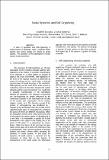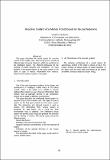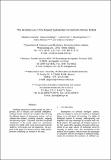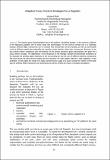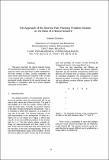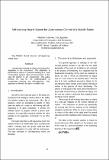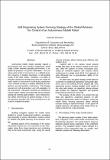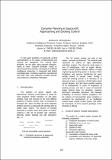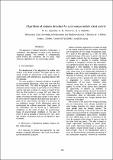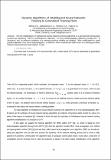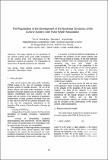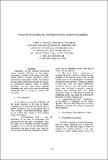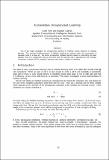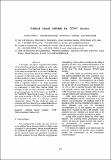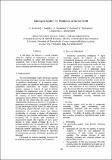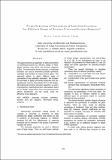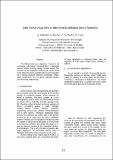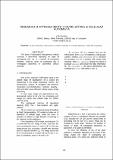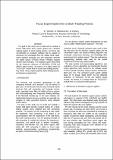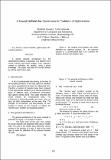Поиск по всему репозиторию:
Посмотр Conference materials by articles по дате загрузки
Отображаемые элементы 1-20 из 39
-
Social Dynamics and Self-Organizing
(BPI, 1999)A view of dynamics and self-organizing of social systems is presented. Both a separate Homo sapiens and human society are viewed as social systems. The dynamics of the development of such systems is also examined.2021-07-27
-
Reactive Control of a Mobile Robot Based on Neural Networks
(BPI, 1999)This paper describes the neural system for reactive control of the mobile robot. The neural system consists of different types of neural networks, which are combined in the intelligent system. The efficient techniques for the training of neural networks are considered. The main problem of the neural ...2021-07-27
-
The Architecture of the Neural System for Control of a Mobile Robot
(BPI, 1999)Building autonomous mobile robots has been a primary aim of robotics and artificial intelligence. Artificial neural networks are capable of performing the different aspecis of autonomous drmng, such as collision-free motions, avoiding obstacles, mapping and planning of path. This paper describes the ...2021-07-27
-
Adaptive Fuzzy Control Strategies for a Zeppelin
(BPI, 1999)The German town Friedrichshafen has an old tradition in building airships. In the moment a follower of the legendary Zeppelin will be build using new technologies. For the control concept this is a challenge because difficult flight manoeuvres are to consider like vertical take off and landing as well ...2021-07-27
-
The Approach of the Shortest Path Planning Problem Solution on the Basis of a Neural Network
(BPI, 1999)This paper describes the neural network solving the shortest path planning problem. It consists of the layer set, where each layer forms a path-candidate for the fixed number of cities. During competition the layer-winner determining the sequence order of cities in the shortest path is selected. In ...2021-07-27
-
Self-training Neural System for Autonomous Control of a Mobile Robot
(BPI, 1999)Unsupervised training is of great importance for adaptation to the emironment. This adaptation is performed by means of continuos training as a result of interaction between robot and emironment. In this case the teacher is the emironment. This paper presents the way for the implementation of unsupervised ...2021-07-27
-
Self-Organizing System Forming Strategy of the Global Behavior for Control of an Autonomous Mobile Robot
(BPI, 1999)Autonomous mobile robots typically require a preconceived and very detailed navigational model (map) of their intended operating emironment. It requires the presence of a priori information. The creating world model of eironment is a difficult problem requiring a detailed description of all possible ...2021-07-27
-
Dynamiс Planning in Spacecraft Approaching and Docking Control
(BPI, 1999)In this paper problems o f spacecraft control automatization on the stages of approaching and docking are considered. For sohing these problems, we are offer using onboard scheduler, based on rules. Onboard scheduler, based on dynamie planning methods, developing in artificial intelligence researches, ...2021-07-27
-
Algorithms of Obstacle Detection for Autonomous Mobile Robot Control
(BPI, 1999)The approach of obstacle detection in this paper is considered. This approach is based on two sequential snapshot analysis. The methods of corresponding points finding are considered. We are using edge detection algorithms for this method approbation.2021-07-27
-
Dynamic Algorithms of Multilayered Neural Networks Training in Generalized Training Plant
(BPI, 1999)The new modifications of multilayered neurak networks training algorithms in a generalized training plant structure are introduced. The first modification for algorithm "on error backpropagation algorithm through time" is introduced and its sufficient conditions of a training procedure stability are ...2021-07-27
-
The Regularities of the Development of the Nonlinear Dynamics of the Control Systems with Pulse-Width Modulation
(BPI, 1999)The paper reports on the dynamics of the control systems with pulse-width modulation of the second kind. The bifurcations of the stationary motions are studied. The regularities of occurrence of chaotic processes are revealed.2021-07-27
-
Temporal Processing Neural Networks for Speech Recognition
(BPI, 1999)Application of the temporal processing neural networks (TPNNs) to the speech recognition is justifled by the nature of the task. Indeed ASR is a sequence recognition problem and assumes incorporation of time into decision process. Static models treat elements of sequence as independent patterns, which ...2021-07-27
-
Є-insensitive Unsupervised Learning
(BPI, 1999)One of the major paradigms for unsupervised learning in Artificial Neural Networks is Hebbian learning. The standard implementations of Hebbian learning are optimal under the assumptions of Gaussian noise in a data set. We derive e-insensitive Hebbian learning based on minimising the least absolute ...2021-07-27
-
Artificial Neural NetWork for DTMF decoders
(BPI, 1999)In this paper, the paltem recognition characteristics of the Artificial Neural Networks (ANNs) are used to realise a real decoder for Dual Tоnе Multi Frequency signals used in the telecommunication field. A new neural architecture, the Multi Leaming Vector Quantization (MLVQ) network, is proposed It ...2021-07-27
-
Intelligent System for Prediction of Sensor Drift
(BPI, 1999)ln this paper the features of neural networks using for improve of measurement accuracy of physical quantities by sensor drift prediction are considered. There is use a technique of data volume increasing for training of predicting neural network by using of separate approximating neural network.2021-07-27
-
On the Detecting of Symmetries of Switching Functions for Eflicient Design of Decision Trees and Decision Diagrams
(BPI, 1999)This paper presents an approach to detect symmetries of switching functions for efficient design of Reed-Muller decision trees (DTs) and decision diagrams (DDs). The information theory measures of switching functions are used to determine possible symmetric variabies and therefore to reduce search ...2021-07-27
-
Data Fusion Algorithm in Intelligent Distributed Sensor Networks
(BPI, 1999)The offered data fusion algorithm is based on the averaging information received from reasonable sensors, whose readings always contain errors. The decision can be appliedfor receiving the most correct result about the object condition that is determined by set of various physical measures (coordinate, ...2021-07-27
-
Research of Optimum Depth of Overlapping in Cellular Automata
(BPI, 1999)The speed of calculations homogeneous cellular automata is determined depending on depth of overlapping with use of a method of overlapped Windows. Optimum depth of overlapping also is investigated depending on parameters cellular automata.2021-07-27
-
Fuzzy Expert System for a Stock Trading Process
(BPI, 1999)The goal of this study was to build and to evaluate a human skill based fuzzy expert system for a decision making support in stock trading process. Our focus was concentrated on Computer software that is capable to reproduce the knowledge from the skilled stock trader. Using classical technique and ...2021-07-27
-
A Neural NetWork for Combinatorial Problems of Optimization
(BPI, 1999)A neural network architecture for the optimization problems is discussed. It is a feedforward neural network with fixed weights. Such approach consists in definition the weights, using a priori knowledge. This paper describes the neural network for solving optimization tasks.2021-07-27
